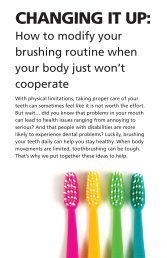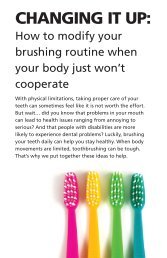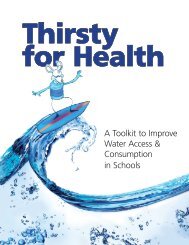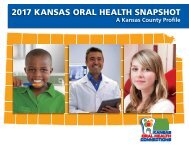2021_Oral_Health_Report_Card_flipbook
Create successful ePaper yourself
Turn your PDF publications into a flip-book with our unique Google optimized e-Paper software.
Kansas scores low on new Oral Health Report Card
February 2021
Oral Health Kansas is pleased to be able to release a new report card on oral health in Kansas. Our
state received a grade of ‘C’ as compared to the nation’s performance on 13 key oral health
indicators. The grade shows Kansas is making progress on improving oral health, but we have a
long way to go to ensure the population of our state is as healthy as possible.
Less than half of Kansas kids enrolled in KanCare are receiving preventive dental visits each year,
and only one in five children under age two is able to visit the dentist. The general population of
children fares better, with 80% of children under the age of 17 visiting the dentist, however nearly
50% of third graders have tooth decay. Tooth decay is the number one chronic childhood disease. 1
Left untreated, it can be deadly, and it is entirely preventable.
About two-thirds of Kansas adults visit the dentist each year. But nearly a third of older adults have
lost six or more teeth due to tooth decay. Adults can and should keep their teeth throughout their
lives. When people keep their natural teeth, they can eat healthy foods more easily and maintain
their confidence. The cost of treating a single decayed tooth over a lifetime can be as much as
$6,000. 2 Less than half of pregnant women in Kansas have their teeth cleaned, yet studies show
that a woman’s oral health during her pregnancy can determine the baby’s risk for tooth decay. 3
The grades in this report card indicate that in nearly all categories, Kansas has a great deal of room
for improvement in comparison to national figures. The disadvantage of this grading scale is its
ability to hide areas for improvement in positive grades. For example, Kansas received an ‘A’ for
meeting 40% of needs in Dental Health Provider Shortage Areas because the national average is
closer to 30%. What the ‘A’ grade does not show is that 60% of dental needs in these provider
shortage areas in our state are going unmet. This is a clear sign of the need for improvement.
The 2021 Kansas Oral Health Report Card should guide our state’s priorities to make the greatest
impact on improving the oral health for all Kansans. For example, Oral Health Kansas currently has
projects focused on improving access to dental care for people with intellectual and developmental
disabilities, pregnant women, and young children, as well as many educational programs to teach
families the importance of oral health in their overall health. We also continue to work to reduce
the number of Dental Health Provider Shortage Areas and increase the number of dental providers
enrolling in the Medicaid program. Oral Health Kansas joined with the Kansas Dental Association to
advocate successfully with the Kansas Legislature for a Medicaid dental rate increase in 2019 and
2020. This is an important way to increase the number of Medicaid dental providers in the state.
Stakeholders in Kansas need to work together to design strategies to ensure all Kansas children
have access to timely and routine preventive care and to dental sealants. We also need to
collaborate on policies to increase access to dental care for adults, including routine affordable care
for pregnant women and older Kansans. More work needs to be done to increase the KanCare








